Governments increasingly rely on AI to deliver services and inform policy—from AI in benefit determinations to algorithms aiding public safety. In the public sector, accountability, fairness, and transparency aren’t just ideals; they are requirements. Effective AI governance is essential to maintain public trust.
Empowering Accountable AI in Government
AI-SDLC Institute guides government agencies in implementing AI with robust governance, ensuring these technologies uphold public values and comply with civic standards. We don’t replace your existing policies or frameworks—we augment them, creating a confluence between our AI lifecycle governance model and the protocols you already follow (like IT procurement rules, data privacy laws, and ethical guidelines).
Our structured approach helps agencies design and deploy AI systems that are transparent, equitable, and effective, aligning with frameworks such as the NIST AI Risk Management Framework and principles like the AI Bill of Rights. By embedding governance into the AI development lifecycle (requirements -> design -> test -> deployment -> monitoring), we ensure government AI tools can be audited, explained, and corrected, just as any traditional public program would be. The Institute’s support means you can innovate with AI in areas like smart city infrastructure or citizen services while meeting oversight mandates and avoiding unintended harms.
The Trinity Framework: Three Pillars of Differentiation
We distill AI mastery into three core pillars, ensuring a structured, repeatable path to success:

Leadership → Mission | Purpose | Focus
Ethical & Fair AI Implementation:
At the core of our approach is ensuring that AI in government is designed and used in an ethical manner. We help incorporate public sector ethical principles (such as fairness, non-discrimination, transparency, and privacy) into each phase of AI development. For example, when developing an AI system for resource allocation or policing, our methods ensure diverse stakeholder input and bias testing are part of the design requirements, echoing civil rights and equity considerations. By instilling these values early, agencies uphold principles like those in the U.S. AI Bill of Rights blueprint (e.g. algorithmic discrimination protections) from day one.
Mission – Define the "why" of AI systems, aligning with human and business needs.
Purpose – Ensure AI initiatives are guided by ethical principles and long-term value.
Focus – Drive AI projects with clarity, structure, and accountability.

Certification → Prepare | Train | Execute
Policy & Framework Alignment:
Rather than adding bureaucracy, AI-SDLC governance dovetails with existing government IT governance and policy frameworks. We map our AI SDLC to standards like the NIST AI Risk Management Framework and relevant regulations (privacy laws, procurement standards, etc.). This pillar ensures your AI projects automatically generate the documentation, risk assessments, and transparency reports needed to satisfy oversight bodies. In practice, this might mean integrating NIST’s “Map, Measure, Manage, Govern” functions into your project management, so compliance and risk mitigation steps are not ad hoc but built-in (House Dems call on White House to make agencies adopt NIST AI framework | FedScoop) (House Dems call on White House to make agencies adopt NIST AI framework | FedScoop).
Prepare – Learn foundational AI-SDLC methodologies.
Train – Gain hands-on experience through structured modules and case studies.
Execute – Validate skills through real-world AI project integration.

Execution → Plan | Build | Scale
Accountability & Oversight Mechanisms:
Accountability & Oversight Mechanisms: We assist in establishing clear oversight and audit processes for AI use. This includes defining responsibility (who “owns” an AI decision), setting up review boards or external audits for sensitive systems, and enabling public transparency where appropriate. Whether it’s an explainability portal for your AI decisions or an internal AI ethics committee, we ensure there are governance bodies and tools watching over AI operations. This pillar resonates with the public sector’s duty to be answerable to citizens: any AI system deployed can be interrogated, its decisions traced, and, if necessary, corrected or improved under supervision.
Plan – Develop structured AI-SDLC roadmaps.
Build – Implement AI solutions with tested frameworks.
Scale – Govern and optimize for long-term operational success.
Ready to get started?
Why AI-SDLC Institute?
Public trust is the bedrock of effective governance. When a government uses AI—be it to assign social benefits, manage traffic, or make policy recommendations—citizens must trust that these systems are fair, unbiased, and under control. Past incidents have shown the fallout when this trust is broken: biased algorithms in public services can lead to public outcry, lawsuits, and harmed communities. Recognizing these stakes, policymakers worldwide are actively developing guidelines to ensure AI serves the public interest. In the United States, for example, the White House released an AI “Bill of Rights” blueprint identifying core protections (like transparency, privacy, and non-discrimination) that should be built into AI systems (House Dems call on White House to make agencies adopt NIST AI framework | FedScoop). Soon after, the National Institute of Standards and Technology (NIST) issued its AI Risk Management Framework, which has been lauded as a “gold standard” for AI governance (House Dems call on White House to make agencies adopt NIST AI framework | FedScoop). Though adoption is voluntary, there’s growing pressure to make frameworks like NIST’s mandatory in federal agencies; congressional leaders have urged the Office of Management and Budget to require all agencies and contractors to follow the NIST AI guidance (House Dems call on White House to make agencies adopt NIST AI framework | FedScoop).
Who Is This For?
The AI-SDLC Institute is designed by and for:
Federal, State & Local Agencies: CIOs, CTOs, and program managers in government departments implementing AI-driven projects (e.g. smart city coordinators, public health data scientists, social services administrators).
Policy Makers & Regulators: Government officials crafting AI policies or oversight frameworks who seek practical guidance on implementation (for instance, a Chief Data Officer in a city government establishing AI usage policies across departments).
Public Sector Compliance & Audit Bodies: Inspectors General, auditors, and ethics officers responsible for reviewing government AI systems for compliance with laws, ethics, and effectiveness. We provide them with frameworks to evaluate AI projects systematically.
Civic Tech and NGO Partners: Though our primary audience is government entities, we also engage with non-profits, NGOs, and civic tech groups that collaborate with governments on AI solutions. Their perspective helps ensure our governance approach is inclusive and addresses community concerns.
In practice, this means public agencies are expected to bake in risk management and ethics from the start. If an agency deploys an AI without these guardrails and it causes an error—say, an algorithm erroneously denies eligible families critical benefits or misidentifies someone in a security context—the impact is not just individual but societal. The legal and reputational consequences can be severe, and public confidence in government technology erodes. Moreover, governments operate under more transparency requirements than private firms: decisions can be subject to FOIA requests, audits, and public scrutiny. Without a systematic governance approach, explaining or defending an AI decision can be nearly impossible (“black box” algorithms won’t suffice when liberties or rights are at stake).
On the positive side, well-governed AI can dramatically enhance public services—allocating resources more efficiently, providing early warnings for public health, and personalizing citizen services—if done with care. Around the world, there’s momentum: the EU’s proposed AI Act will enforce strict requirements on public-sector AI (like any AI used in law enforcement or judiciary is deemed high-risk). Leading governments in Canada, UK, and Singapore are also issuing AI ethics frameworks for their civil services. By adopting AI-SDLC Institute’s governance blueprint, public sector organizations not only mitigate risks but position themselves as forward-thinking and accountable. They ensure that AI becomes a tool to strengthen public trust (through improved services and open oversight) instead of a liability. In short, governance is how we make AI in government as worthy of citizens’ confidence as traditional public programs.
Join the Movement. Lead the Future.
We call on public sector leaders and technologists to join us in creating AI systems that citizens can trust. The AI-SDLC Institute offers a platform for sharing knowledge and developing skills to govern AI effectively in government. When you engage with us, you become part of an interagency and cross-sector dialogue on best practices – from implementing the NIST AI Risk Framework in a federal agency, to applying ethics checklists in a local government pilot. We encourage you to bring your agency’s AI challenges and questions into our community. By learning together, testing ideas, and even contributing to research on public sector AI governance, you will help set the standards for how governments everywhere harness AI responsibly. Let’s work together to ensure that every algorithm deployed in the public sphere is transparent, equitable, and accountable to the people it serves.

Public Sector AI Governance Workshops:
We offer targeted workshops and training for government teams on implementing AI governance. These sessions cover how to apply our AI-SDLC framework alongside government guidelines like NIST’s AI RMF or your agency’s specific AI policies. Through real-world scenarios (e.g., an AI system for eligibility determination or predictive policing), civil servants learn how to identify risks, document decisions, and ensure lawful and ethical use of AI. Completion can lead to certification in our governance program, signaling your team’s competence in responsible AI.
Advisory Services & Compliance Alignment:
Our experts are available to advise on specific projects or policy development. We’ll help map your AI projects to existing laws (ADA, GDPR for citizen data, sector-specific regulations) and ethical principles. If you’re drafting an internal AI policy or guidelines for contractors, we ensure it harmonizes with broader standards and the AI-SDLC best practices. This one-on-one guidance is part of our membership services, focused on empowering your internal governance capabilities (we do not replace your decision-making authority; we strengthen it with knowledge and proven approaches).
Framework Implementation Support:
Agencies can access AI-SDLC Institute’s repository of templates, checklists, and process guides crafted for public sector needs. For example, we provide templates for Algorithmic Impact Assessments (as recommended in many jurisdictions) and data accountability reports. Our materials align with open government principles, making it easier to produce public-facing documentation about your AI system’s purpose, design, and safeguards. By using our tools, your agency can meet transparency or reporting mandates with confidence.
Government AI Governance Network:
As a member, you join a confidential network of peers across governments and public institutions. Through moderated forums and periodic virtual roundtables, members exchange lessons learned. For instance, a city government might share how they set up an AI oversight committee, while a federal agency might discuss approaches to algorithmic bias testing in procurement. These peer insights, facilitated by our Institute, help you benchmark and continuously improve your own AI governance. Additionally, you gain early access to our research reports and case studies on public sector AI governance, keeping you informed of trends and global best practices.
6+
EVENTS A YEAR
40+
SOPs
30+
YEARS OF EXPERIENCE
2,640+
INFLUENCERS
The Challenges AI Leaders Face
OPPORTUNITIES
Speed to Market: AI-SDLC accelerates deployment without sacrificing compliance.
Cost & Risk Management: Our structured frameworks reduce AI implementation costs and legal exposure.
Safety & Reliability: Proactively mitigate ethical, legal, and technical risks through AI-IRB oversight
Lead by example in the public sector’s AI journey.
By partnering with AI-SDLC Institute, your agency can demonstrate how to innovate with AI responsibly and transparently. Reach out to us today to strengthen the governance of your AI projects. Together, we’ll ensure government AI systems are not only powerful and efficient but also worthy of the public’s trust and aligned with our democratic values.
What The AI Leaders Are Saying

OpenAI
The AI-SDLC Institute's commitment to ethical AI governance and its comprehensive approach to training and certification resonate deeply with the current needs of the AI community. Its focus on leadership and structured execution frameworks offers valuable guidance for organizations aiming to navigate the complexities of AI development responsibly."

Meta
The AI-SDLC Institute is a professional resource for AI professionals focusing on the Systems Development Life Cycle (SDLC) of AI and Machine Learning (ML) systems. I think the AI-SDLC Institute has a solid foundation and a clear direction, a valuable resource for AI professionals and researchers."

